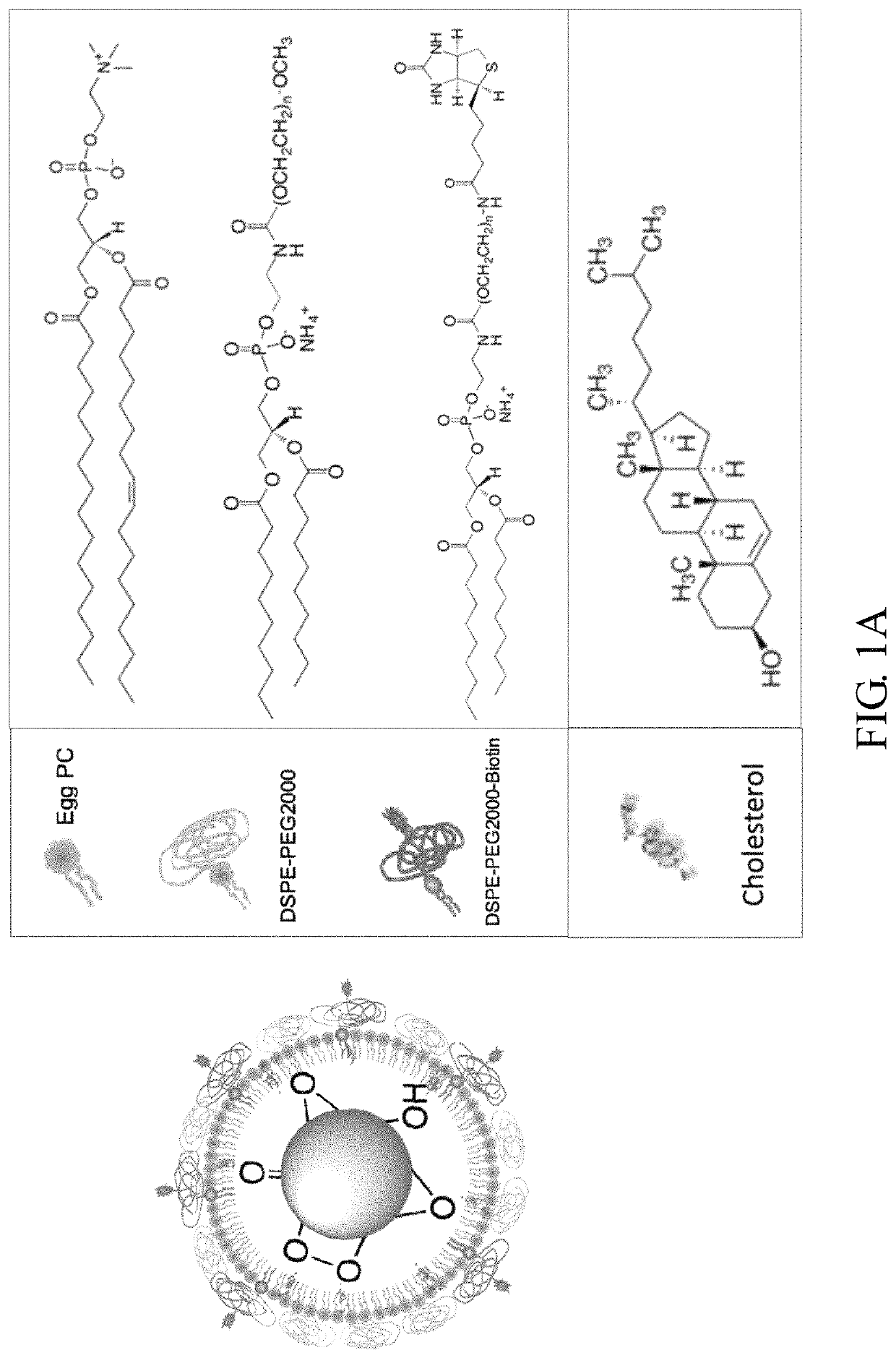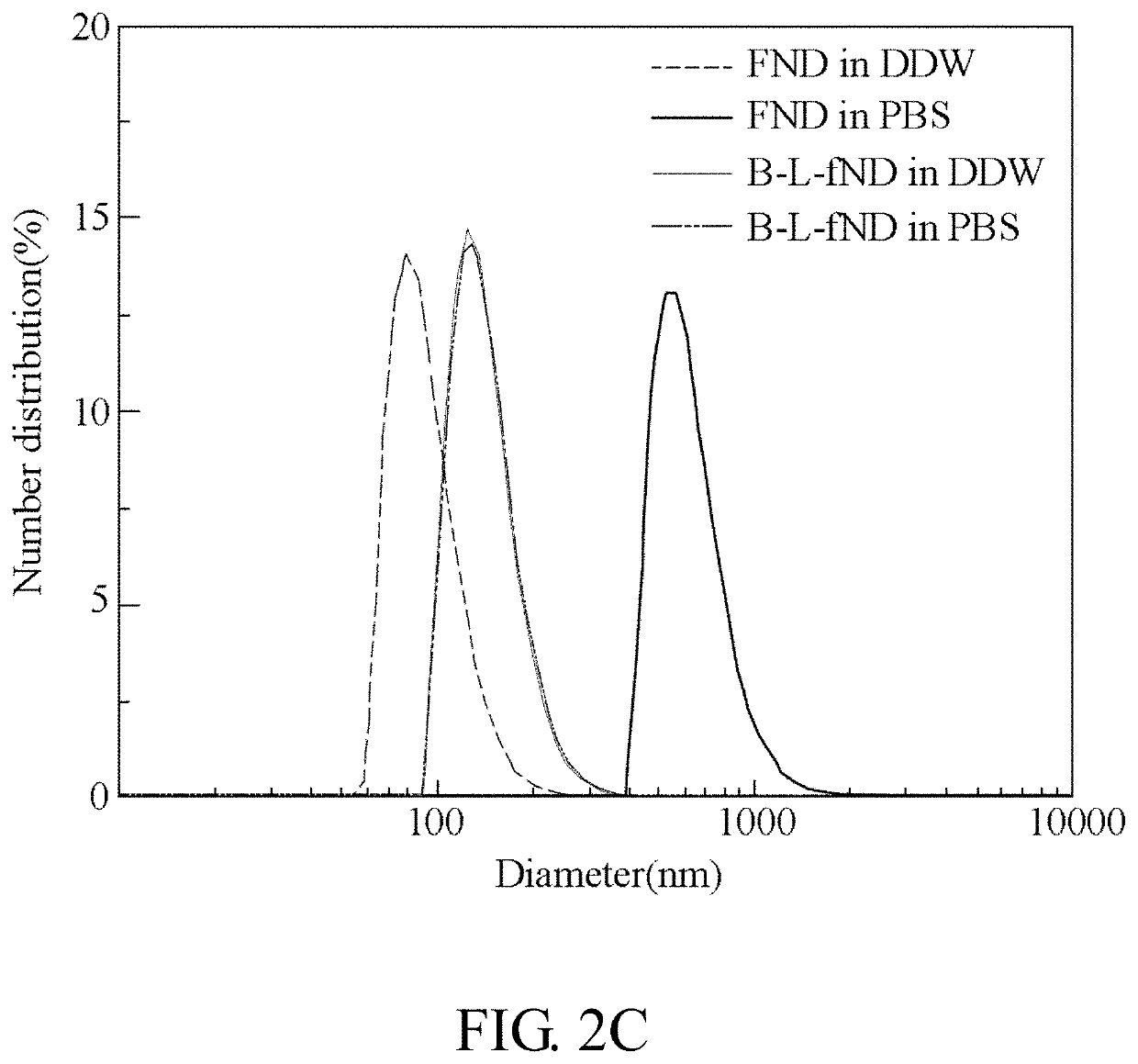Encapsulated functionalized diamond crystal
a functionalized diamond and crystal technology, applied in the field of functionalized diamond crystals, can solve problems such as false positives, and achieve the effects of high phototability, long fluorescence lifetime, and unique magneto-optical properties
- Summary
- Abstract
- Description
- Claims
- Application Information
AI Technical Summary
Benefits of technology
Problems solved by technology
Method used
Image
Examples
experimental example 1
[0069]The experiment began with the synthesis of lipid-coated FNDs functionalized with biotin groups (bL-FND) based on the thin-film hydration method.24 It is found that the bL-FND prepared in this manner could be dispersed well in high ionic strength solution (such as PBS), but much non-specific targeting was present during the cell labeling (data no shown), which could be a result of incomplete lipid encapsulation of the particles. FND is a carbon-based material and its surface hydrophobicity can be properly tuned by chemical modification.25 Phospholipid is a bipolar material, which has a hydrophilic head and two hydrophobic tails. Mixing these two compounds together should allow the hydrophobic tail of phospholipid to bind with FND and the hydrophilic head of it points toward water. Hence, in this embodiment, it has been tried to produce bL-FND by using the solvent evaporation method based on the Ouzo effect, where the lipid mixture was first dissolved in tetrahydrofuran (THF), f...
experimental example 2
[0079]In an illustration for the usefulness of bL-FNDs as fluorescent markers, the bL-FNDs were applied to label CD44 antigens on the surface of HeLa cells by sandwich immunostaining (FIG. 16. Briefly, HeLa cells were first fixed with 4% paraformaldehyde. They were then sequentially stained with biotinylated anti-CD44 antibodies, DyLight®488 conjugated neutravidin, and bL-FNDs at a particle concentration of 100 μg / mL for 30 min (FIG. 16). Confocal fluorescence imaging of the cells showed good co-localization of FND and DyLight®488 (B in FIG. 3) on cell membrane, confirming the high specific labeling capability of the particles. The fluorescence images were acquired by laser excitation at 488 nm for DyLight®488 and at 561 nm for FND, and their corresponding fluorescence emission was collected at 500-550 nm and 600-800 nm, respectively. To determine the optimal content of biotin on the FND surface, bL-FNDs with different molar ratios of biotin (i.e., 0%, 0.5% or 1%) were produced to l...
experimental example 3
n
[0084]The observation that the surface antigens were not completely targeted or saturated even at the concentration of 700 μg / mL (FIG. 5) suggested that the number of the particles is too low for labeling. For 100-nm bL-FND, the concentration of 700 μg / mL corresponds to 4×1011 particles / mL, which is lower than DyLight®488 (1 mM) by more than 6 orders of magnitude. To overcome this limitation but keep the weight concentration the same at 100 μg / mL, the particle size was reduced to be from 100, 50, to 35 nm, which effectively increases the particle number by 1-, 8-, to 24-fold. (FIGS. 6A-6C) Next, absolute quantification of the bL-FNDs on HeLa cell surface was performed by using a magnetically modulated fluorescence technique as described in the previously work for these three types of particles made by the inventors.28 Briefly, cells labeled with bL-FNDs were sonicated to release the particles from the membrane. The sonicated cell suspension was then measured with a home-built fluor...
PUM
| Property | Measurement | Unit |
|---|---|---|
| diameter | aaaaa | aaaaa |
| concentration | aaaaa | aaaaa |
| Size distributions | aaaaa | aaaaa |
Abstract
Description
Claims
Application Information
 Login to View More
Login to View More - R&D
- Intellectual Property
- Life Sciences
- Materials
- Tech Scout
- Unparalleled Data Quality
- Higher Quality Content
- 60% Fewer Hallucinations
Browse by: Latest US Patents, China's latest patents, Technical Efficacy Thesaurus, Application Domain, Technology Topic, Popular Technical Reports.
© 2025 PatSnap. All rights reserved.Legal|Privacy policy|Modern Slavery Act Transparency Statement|Sitemap|About US| Contact US: help@patsnap.com



